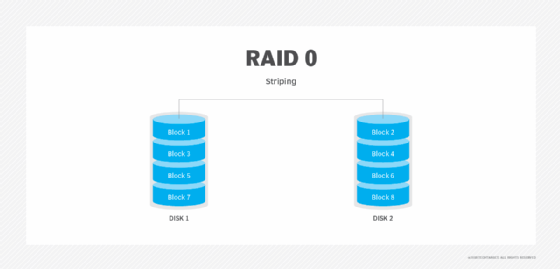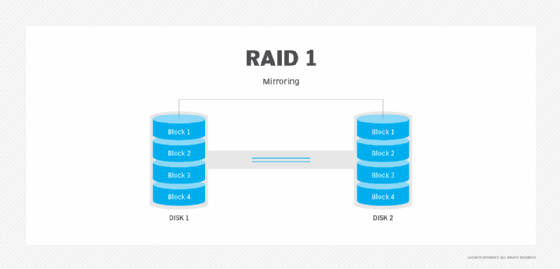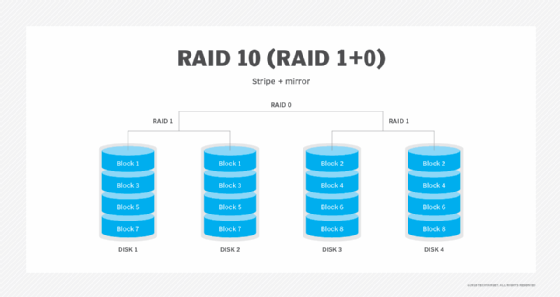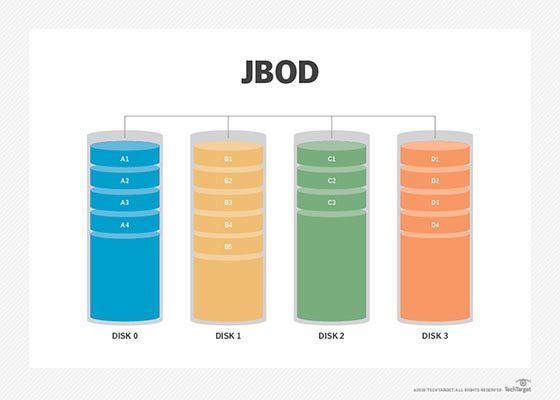What is RAID 0 (disk striping)?
RAID 0 (disk striping) is the process of dividing a body of data into blocks and spreading the data blocks across multiple storage devices, such as hard disk drives (HDDs) or solid-state drives (SSDs), in a redundant array of independent disks group.
Some RAID levels use disk striping to distribute and store data across multiple physical drives. Disk striping is synonymous with RAID 0 and spreads the data across all the drives in a RAID group without parity data.
What does RAID 0 do?
In general, RAID (redundant array of independent disks) is a way of arranging multiple storage devices so they can work together as a single device in order to host a single volume. RAID 0 is one of the ways available to create such an arrangement.
In RAID 0, the data is broken into segments or stripes and distributed across two or more storage devices in a storage array. Those devices are then grouped as one unit to maximize storage capacity and performance. Also, spreading data across multiple drives improves data access speeds.
Is RAID 0 a mirror or stripe?
Striping is an important concept in RAID 0. In fact, RAID 0 is known as a stripe set, with data divided across the set of drives. A striped unit refers to the data slice that resides on an individual drive.
Since multiple devices are used to write data, that data can be written and read much faster than would be possible with just a single disk. Depending on the system, RAID 0 will combine the devices in the storage array and write data on all of them, either simultaneously or sequentially.
The concept of mirroring is applicable to RAID 1, in which two or more drives are exact duplicates or mirrors of one another. Since the same data is written to two drives at the same time, they are always in sync with one another. This provides protection against drive failure, ensuring that the storage volume can be accessed even if one of the disks fails. Such protection is not available with RAID 0 because the disks are striped rather than mirrored.
How RAID 0 works
With RAID 0, striping spreads data across several physical drives. Each stripe or block of data is alternately and simultaneously written to multiple drives. So, if there are four drives in the RAID 0 array, stripe 1 may be written to drive 1, stripe 2 to drive 2, stripe 3 to drive 3 and stripe 4 to drive 4. Stripes 1 and 2 may be written to drives 1 and 2, respectively, and at the same time. The same goes for stripes 3 and 4 with drives 3 and 4. This method ensures that multiple drives can access the contents of a file, enabling writes and reads to be completed more quickly.
Storage systems perform disk striping in different ways. A system may stripe data at the byte, block or partition level, or it can stripe data across all or some of the drives in a cluster. For instance, a storage system with 10 drives might stripe a 64 KB block on the first, second, third, fourth and fifth drives and then start over again at the first drive. Another system might stripe 1 MB of data on each of its 10 drives before returning to the first drive to repeat the process.

Uses of RAID 0
In RAID 0, the striping process distributes data across multiple drives to improve speed and performance. However, if one drive happens to fail, the entire RAID array will fail. Adding more drives to a RAID 0 array delivers even more speed improvements, but it also increases the probability of array failure. For these reasons, RAID 0 is best for storage that is noncritical but requires high-speed reads and writes.
Due to the speed and performance benefits offered by RAID 0, caching live streaming video and video editing are common uses for this RAID level. Furthermore, striping without data redundancy may be used to store temporary data or to create scratch space. It can also be useful for situations where a master copy of the data needs to be easily recoverable from another storage device.
Disk striping with parity
RAID 0 stripes data, but without parity used in other types of RAID. For instance, RAID 3 and RAID 4 use a dedicated parity drive, while RAID 5 distributes its parity information across drives. RAID 6 uses two drives for parity so it can protect against two drive failures. Data protection can be extended beyond two storage device failures using erasure coding. Like RAID 0, RAID 1 does not have parity.
Parity data is commonly calculated by using the binary exclusive function stored on a physical drive in the RAID set. If a storage drive in the striped RAID set fails, the data is recoverable from the remaining drives and the parity stripe.
For a data set with n drives, the data might be striped on drives n through n - 1, and the nth drive would be reserved for parity. For example, in a RAID set with 10 drives, data could be striped to nine drives with the 10th drive used for parity.
The lack of parity bits means that RAID 0 offers no protection against disk failure. That said, the disadvantage of disk striping with parity is the performance penalty for small random writes, as the system accesses all the stripe units in the striped RAID set. Since the use of parity bits has both advantages and disadvantages, it's important to first check the storage requirements and goals before selecting the RAID level.

Is RAID 0 hot-swappable?
Since RAID 0 lacks data redundancy, the failure of one drive in the array will result in all data being lost. Even swapping out the failed drive cannot recover the data. Without a rebuild mechanism, swapping out drives has no benefit. This is why RAID 0 is not considered hot-swappable.
Some other RAID mechanisms provide the striping capability of RAID 0 along with hot-swappability. One example is RAID 5. In that configuration, the failure of one drive will not result in complete data loss. If anything, the failed drive can be replaced with another drive and the RAID configuration will be re-created automatically. RAID 5 is a better setup for storing critical data whose loss can have catastrophic consequences.
Advantages and disadvantages of RAID 0
The main advantage of RAID 0 and disk striping is improved performance. For example, striping data across three drives would provide three times the bandwidth of a single drive. If each drive runs at 200 IOPS, disk striping would make available up to 600 IOPS for data reads and writes.
RAID 0 avoids overhead by not using parity data and by using all of the data storage capacity available. This is why RAID 0 offers high data capacity that's hard to match by the other RAID configurations. RAID 0 is also easy to implement. Furthermore, it has the lowest cost of all the RAID levels, and all hardware controllers support it.
However, the fact that RAID 0 does not have parity unlike other RAID levels is one of its key drawbacks. While data is broken down into stripes and spread over multiple HDDs or SSDs to improve writing and access speeds, parity bits -- which are additional or redundant binary digits -- are not stored on the devices. As a result, there's no way for the storage array to check if there are any missing segments or other errors in the stored data.
Another disadvantage of the data striping process in RAID 0 is low resiliency. RAID 0 does not have data redundancy or fault-tolerance, the failure of any physical drive in the striped drive set results in the loss of the data on the striped unit and, consequently, the loss of the entire data set stored across the striped set.
RAID 0 vs. RAID 1
In a RAID array, mirroring -- also known as RAID 1 -- duplicates data from one drive to another. This creates data redundancy, which will aid in recovery if an array fails. Like striping, mirroring provides high performance. The mirroring in RAID 1 also has the benefit of providing high availability and rapid recovery but cannot match the speedy reads and writes of RAID 0. The disadvantage of mirroring is the 50% overhead inherent in using half the capacity to make an exact copy of the data for protection.

If there is an even number of drives, striping can be combined with mirroring to speed up performance and expand capacity by striping data across multiple sets of mirrored drives. This combination is also called RAID 10 (also referred to as RAID 1+0 or hybrid RAID). RAID 10 increases speed and provides the advantages of redundancy and fault tolerance. However, it provides less capacity than RAID 0 and is also costlier due to the use of more drives in the storage array.

RAID 0 vs. RAID 5, JBOD and SSDs
RAID 5 is a commonly used version of RAID. It can be combined with RAID 0 or used as an alternative. RAID 5 can provide more economical redundancy and stripes data across drives while distributing parity. It provides more usable storage than RAID 1. Also, the drives are hot-swappable so a failed drive can be easily replaced with another drive to minimize data losses.
However, RAID 5 has the disadvantage of reduced performance during rebuilds. Also, RAID 5 does not offer the same high capacities as RAID 0 or the same high speeds as RAID 1 since it creates parity bits and uses processing power to create the bits and storage space to store them.
Outside of other RAID levels, alternatives to disk striping can include JBOD (just a bunch of disks) and SSDs. Like RAID 0, JBOD is composed of multiple physical drives. While the drives in RAID arrays need to be of similar capacity, those in JBOD arrays can vary.

Like RAID 0, a JBOD array uses all available storage capacity, not reserving any for redundancy. This makes a JBOD array a cost-effective alternative to many RAID arrays. However, JBOD arrays don't come close to the speed of RAID with reads and writes, especially not the accelerated reads and writes of RAID 0.
SSDs are growing in popularity as prices go down, thanks to their rapid speeds and increasing capacities. Of all the RAID levels, RAID 0 comes the closest to the read and write speeds of SSDs. However, RAID 0 cannot exactly match the speed and performance provided by an SSD. Also, RAID controller throughput and general processing speeds are limited in RAID 0.
That said, SSDs are still more expensive than an economical RAID array. This is why the choice of drive types may ultimately come down to determining the priority between speed requirements, performance requirements and costs.
RAID protects data and improves storage performance and availability. The technology can be confusing, however. Read about the different levels of RAID, the pros and cons, and where they work best. Also, explore the key differences in software RAID vs. hardware RAID.






